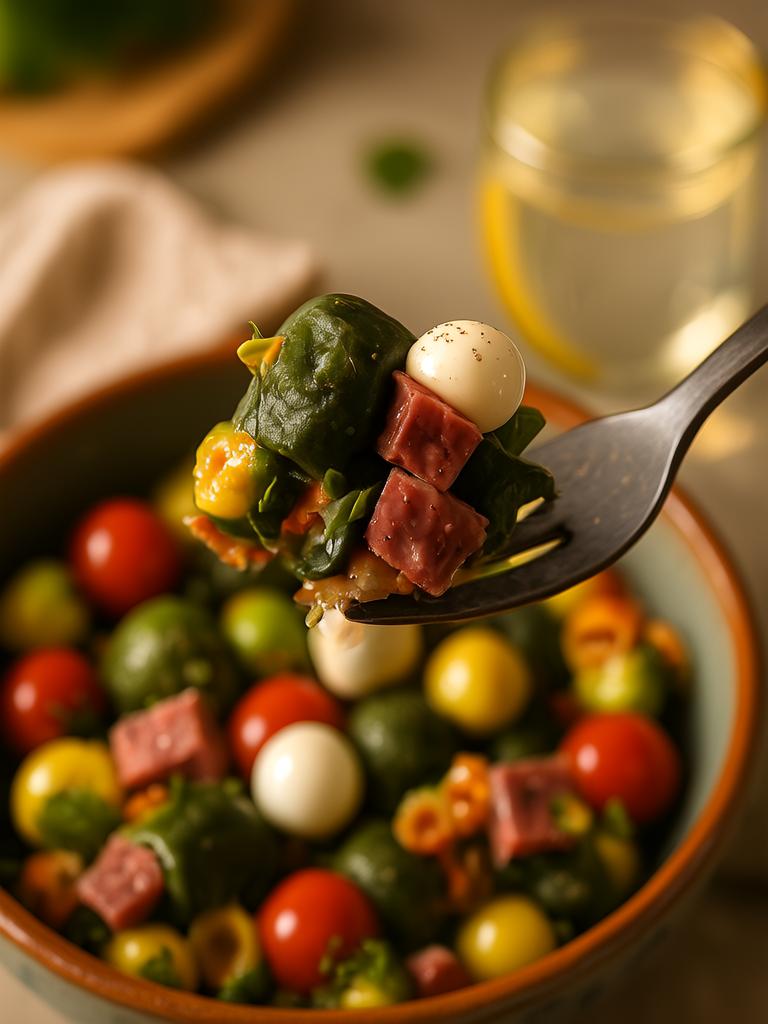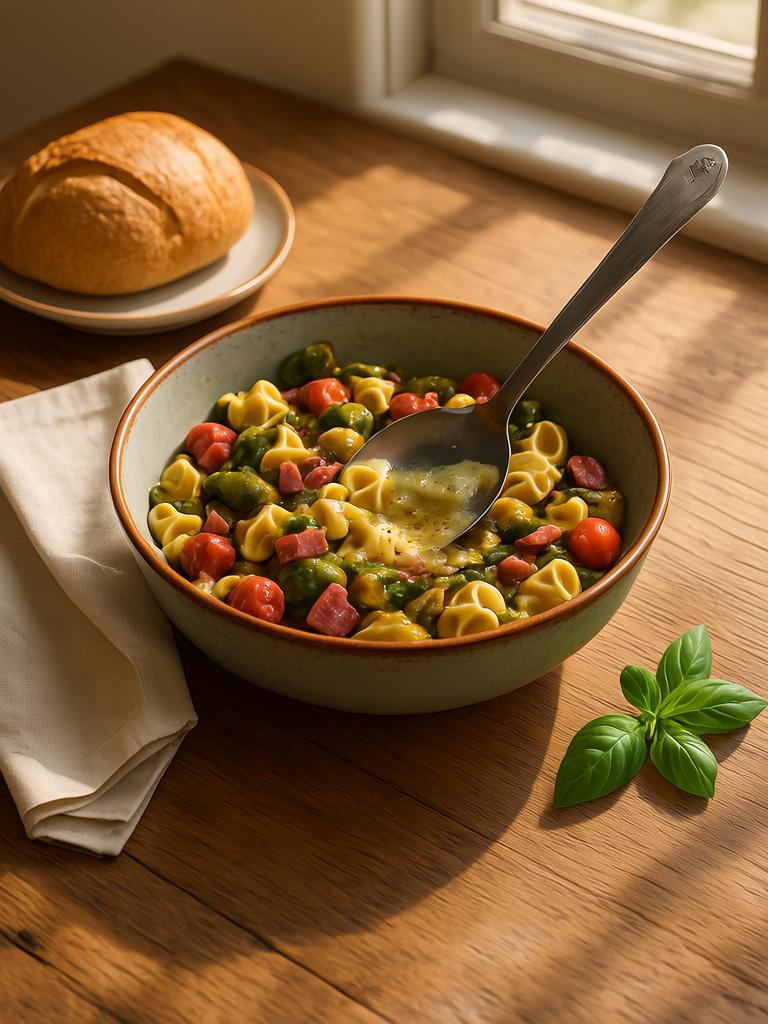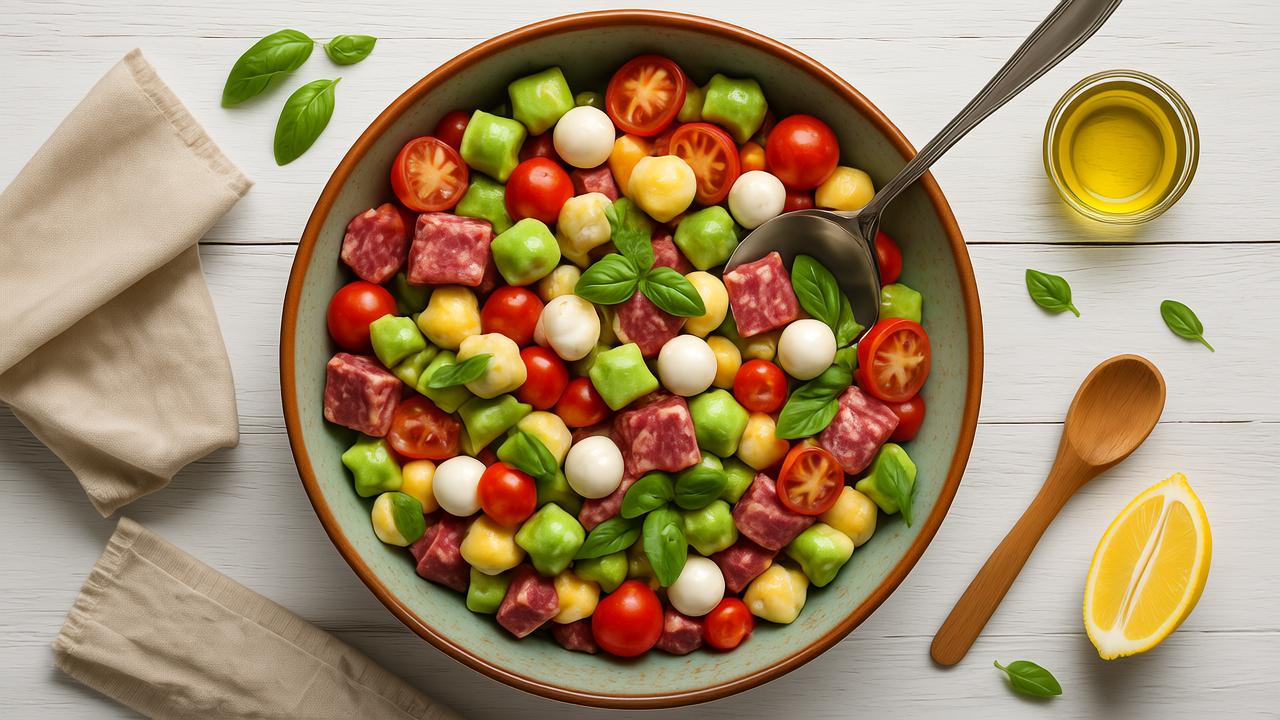If there’s one dish that slips under the radar at summer cookouts and lunch counters alike—yet manages to steal the spotlight every single time—it’s the salami-mozzarella tortellini pasta salad. It’s cold, yes, but never boring. It’s pasta, but also protein-packed. It’s picnic-friendly but polished enough for a catered lunch. This ain’t your average limp elbow macaroni drowning in mayo.
Professionals in the culinary field—chefs, caterers, recipe developers—need more than just a good flavor combo. They need balance, prep efficiency, storage reliability, and something that plates well without reheating. This pasta salad delivers. Big time.
Let’s talk why, how, and what makes it tick.
Why Salami-Mozzarella Tortellini Pasta Salad Is More Than a Side Dish
This dish might seem simple. Cheese-filled pasta. Cured meat. Fresh veg. Dressing. Boom. Done. But behind its simplicity lies some serious flavor architecture.
First off—texture. Tortellini provides chew and density, anchoring the dish. The salami brings snap and savory punch. Mozzarella? It smooths it all out, offering a cool, creamy contrast. Add tomatoes, olives, red onion, or even a sharp arugula… and suddenly it’s a full-blown meal.
Unlike mayo-based pasta salads, this one leans into olive oil or vinaigrette dressings. Why does that matter for professionals? Stability. It won’t break down, separate, or congeal when cold. This makes it golden for buffets, events, and packed fridges.
And there’s the logistics angle: It holds up brilliantly under refrigeration. Make it 24 hours in advance? No problem. In fact, that gives the flavors time to deepen. Rarely do you get convenience and crave-worthiness in the same bite. But here? You do.

Tortellini: The Star Carb, but Pick Right
Tortellini’s not just pasta. It’s pasta with filling. That’s a double act. Cheese-stuffed tortellini is the classic choice. Ricotta, Parmesan, sometimes a touch of nutmeg. Mild enough to pair with bolder elements but still rich.
But don’t grab any random brand and call it a day.
Fresh tortellini from the refrigerated section gives a better mouthfeel than dried. It’s silkier, holds its shape when cold, and reheats more evenly if needed. Dry tortellini can go a bit chewy, almost plasticky, especially if overcooked. Professionals—especially in catering—should know this firsthand.
Cook it al dente. Seriously. One minute less than the package says. Remember, it’ll continue softening as it sits in dressing.
Want to step up the base? Use spinach tortellini for color contrast or even prosciutto-stuffed ones for double meat impact. Just be sure it doesn’t overpower the balance.
Salami: Choose Your Warrior
Salami can make or break this dish. Too fatty and it clumps. Too lean and it gets lost. Go for hard salami or Genoa, sliced into small strips or quartered slices. You want it to mingle, not dominate.
Here’s the thing a lotta people mess up—don’t toss it in straight from the fridge. Let it come to room temp before slicing. Cold fat resists the knife and you’ll end up with jagged chunks instead of clean slivers.
And don’t be afraid to mix it up. Soppressata, calabrese, or even spicy chorizo (yep, try that once) can add an unexpected edge. Just keep the ratio right: around 1 part salami to 3 parts pasta by volume. Any more and it’s a meat tray.
Mozzarella: Creamy, But Not Mushy
Mozzarella’s role here is crucial. You’re looking for small pearls, aka ciliegine. Why? Size. They’re ready to toss straight in. And their texture holds up better than large balls cut down (which leak moisture fast).
Don’t use the shredded stuff. It’s dry, stringy, and engineered to melt—not to eat cold. Professionals know: cold cheese must be chosen on purpose.
If ciliegine’s not available, cube up fresh mozzarella from a log. Drain it well. Even give it a quick pat with a paper towel. Waterlogged cheese ruins a vinaigrette.
You could swap in marinated bocconcini for flavor-layering. Those herby oils bring dimension that simple olive oil can’t.
Add-Ins That Elevate, Not Distract
Now’s where you build nuance. Color, crunch, acid.
Here’s a solid add-in list (though don’t use all of them together unless you want chaos):
- Cherry tomatoes (halved, salted slightly to pull flavor)
- Kalamata or castelvetrano olives (pitted, sliced)
- Thinly sliced red onion (quick pickled? even better)
- Roasted red peppers
- Chopped artichoke hearts
- Arugula or baby spinach
- Pepperoncini slices
Avoid cucumbers or watery veggies—they break down too fast and dilute the dressing. Professionals prepping ahead for events should stick with firm, briny, or roasted ingredients.

The Dressing: Vinaigrette Is King
Forget heavy dressings. This salad shines with vinaigrette.
A basic combo:
Olive oil + red wine vinegar + Dijon mustard + minced garlic + oregano + salt + cracked black pepper.
Add a touch of honey or maple if you like contrast. Want a shortcut? High-quality bottled Italian dressing works if you know the brand. (Ken’s Steakhouse is a sleeper hit in commercial kitchens, FYI.)
Use a ratio of about 1/4 cup dressing per 1 pound cooked tortellini. Then—here’s the pro move—reserve half the dressing. Add it after chilling. Tortellini soaks up flavor fast, and by the next day, your salad might be dry if you don’t freshen it up before serving.
Chill Time Is Build Time
Professionals don’t serve pasta salad straight off the stove. That’s a warm mess, not a dish.
Let the tortellini cool a bit before tossing with dressing. Never rinse it (unless it’s way overcooked)—you’ll strip flavor. Instead, spread it on a sheet pan, toss with a tiny bit of oil to stop sticking, and cool it fast.
Once it hits room temp, mix in the salami, mozzarella, and dressing. Then refrigerate for at least 2 hours. Overnight is best. Flavors marry. Textures settle.
Pro tip: Toss again just before plating. Cold dressing tends to congeal slightly. A quick mix brings it back to life.
Common Mistakes (and How Pros Avoid ‘Em)
- Overcooking the tortellini
A soggy base makes the whole thing feel like mush. Always undercook by a hair. - Underseasoning the dressing
Pasta absorbs more salt and acid than you’d think. Taste it cold—flavors are muted when chilled. - Skipping rest time
You need at least an hour in the fridge to call this a salad. Anything less and it’s just a warm jumble. - Using watery veggies
Tomatoes are fine. Cucumbers, not so much. Wet ingredients dilute flavor. - Too much dressing at the start
Tortellini expands. What looks like enough oil now will disappear by tomorrow. Save some to refresh.
Emerging Trends: What’s Next in Cold Pasta Salads?
Professional kitchens and food influencers alike are rethinking the humble pasta salad. Here’s what’s bubbling up:
- Global mashups: Think gochujang vinaigrette with scallions and sesame, or za’atar oil with chickpeas and labneh balls. Wild? Maybe. But customers are into bold twists.
- Plant-based salami alternatives: Seitan or jackfruit versions give meat-free diners a similar bite without compromising taste.
- Ferments and pickles: More chefs are incorporating pickled fennel, kraut, or miso-marinated veg for depth.
- Modular prep: Prep each component separately, store cold, and assemble to order. Keeps everything from going limp in bulk service.
Real-World Example: Catered Wedding Success
Last summer, I helped cater a farm-to-table wedding in upstate New York. They wanted a cold buffet-style lunch post-ceremony. Hot food was out—power issues. We did a trio of cold mains, but the salami-mozzarella tortellini pasta salad? Gone first. Even before the smoked trout spread or roasted chicken salad.
What worked? We used a red pepper vinaigrette, added marinated artichokes and blanched green beans for snap. Dressed half that morning, the other half just before the buffet opened. Not a single bite came back to the kitchen.
Final Thoughts: What Makes It Work, and Why You Should Make It
Salami-mozzarella tortellini pasta salad seems easy. And sure—it can be. But when you lean in, dial the ratios, nail the textures, and balance that acid-fat-carb trinity? You get a dish that sings.
It’s a professional’s dream: scalable, make-ahead, travel-friendly, flavor-dense. It works in food trucks, wedding menus, corporate boxed lunches, and home kitchens alike.
So whether you’re feeding 5 guests or 500, this dish doesn’t just show up. It shows off.
Go make it better than anyone else.
FAQs
What type of tortellini is best for pasta salad?
Fresh, cheese-filled tortellini from the refrigerated section gives the best texture and flavor.
Can I use dry tortellini instead of fresh?
Yes, but it may turn chewy or rubbery—cook it just until al dente.
What kind of salami should I use?
Hard salami or Genoa works best; slice it thin for better distribution.
Can I substitute the mozzarella?
Yes, use marinated bocconcini or cubed fresh mozzarella—avoid shredded.
How long should I chill the salad before serving?
At least 2 hours, but overnight is ideal for full flavor.
Should I dress the salad all at once?
No, save half the dressing to refresh it before serving.
What’s the best dressing for this salad?
A zesty vinaigrette with olive oil, vinegar, garlic, and herbs.
Can I make this pasta salad ahead of time?
Yes, it holds up great in the fridge for up to 3 days.
Is this salad good for catering or meal prep?
Absolutely—it’s stable, doesn’t spoil fast, and travels well.
How do I keep the mozzarella from getting soggy?
Drain it well and pat dry before mixing into the salad.

Mariana is a passionate home cook who creates delicious, easy-to-follow recipes for busy people. From energizing breakfasts to satisfying dinners and indulgent desserts, her dishes are designed to fuel both your body and hustle.
When she’s not in the kitchen, she’s exploring new flavors and dreaming up her next recipe to share with the Foodie Hustle community.

